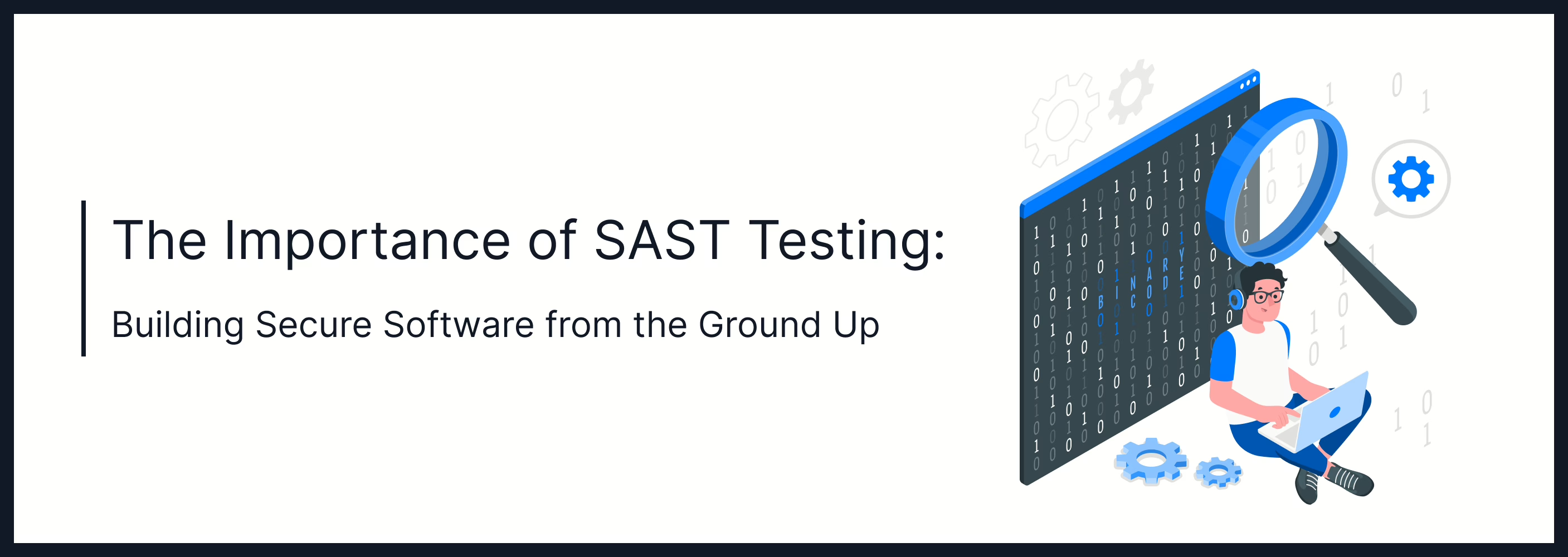
Oct 15, 2024 Information hub
The Importance of SAST Testing: Building Secure Software from the Ground Up
In today’s fast-paced digital world, software security is more critical than ever. With cyberattacks becoming increasingly sophisticated, organizations must ensure that their software is secure from the ground up. One of the most effective ways to achieve this is through SAST testing. In this blog post, we will explore what this testing is, why it is essential, and how it can help organizations build secure software. We will also delve into current trends, challenges, and future developments in the field of this testing, providing practical examples and actionable insights along the way.
What is SAST Testing?
SAST stands for Static Application Security Testing. It is a white-box testing method that analyzes an application’s source code, bytecode, or binary code to identify security vulnerabilities. Unlike dynamic testing methods, which require the application to be running, SAST testing is performed early in the software development lifecycle (SDLC), typically during the coding phase. This allows developers to detect and fix security issues before the software is deployed, reducing the risk of vulnerabilities being exploited in production.
Why is SAST Testing Important?
SAST testing plays a crucial role in ensuring the security of software applications. Here are some key reasons why it is important:
- Early Detection of Vulnerabilities: It allows developers to identify security flaws early in the development process, reducing the cost and effort required to fix them later.
- Comprehensive Coverage: SAST tools can analyze the entire codebase, including third-party libraries and dependencies, ensuring that no part of the application is left unchecked.
- Compliance with Security Standards: Many industries have strict security regulations, such as PCI-DSS, HIPAA, and GDPR. It helps organizations meet these requirements by ensuring that their software is secure.
- Reduced Risk of Data Breaches: By identifying and fixing vulnerabilities early, SAST testing reduces the risk of data breaches and other security incidents, protecting both the organization and its customers.
The Relevance of SAST Testing Today
In the current digital landscape, where software is the backbone of almost every business, the relevance of SAST testing cannot be overstated. Cyberattacks are on the rise, with hackers constantly looking for vulnerabilities to exploit. According to a report by IBM Security, the average cost of a data breach in 2021 was $4.24 million, the highest in 17 years. This highlights the importance of securing software applications to prevent costly breaches.
Moreover, with the increasing adoption of DevOps and Agile methodologies, the need for security testing to be integrated into the development process has become more critical. This fits perfectly into these methodologies, as it can be automated and integrated into the CI/CD pipeline, allowing developers to continuously monitor and improve the security of their code.
SAST Testing Practical Example: The Equifax Data Breach
One of the most infamous examples of a security breach caused by a software vulnerability is the Equifax data breach in 2017. The breach, which exposed the personal information of 147.9 million people, was caused by a vulnerability in the Apache Struts framework used by Equifax. Had SAST testing been implemented, this vulnerability could have been detected and fixed before the breach occurred, potentially saving the company millions of dollars in damages and reputational harm.
How SAST Testing Works
It involves analyzing the source code of an application to identify security vulnerabilities. Here’s a step-by-step breakdown of how it works:
1. Code Analysis
SAST tools scan the application’s source code, bytecode, or binary code to identify potential security vulnerabilities. These tools use a combination of pattern matching, data flow analysis, and control flow analysis to detect issues such as:
- SQL Injection
- Cross-Site Scripting (XSS)
- Buffer Overflows
- Insecure Deserialization
- Hardcoded Credentials
2. Vulnerability Identification
Once the code has been analyzed, the SAST tool generates a report that lists the identified vulnerabilities, along with their severity levels. This allows developers to prioritize which issues to address first.
3. Remediation
After vulnerabilities have been identified, developers can begin the process of remediation. This involves fixing the code to eliminate the security flaws. SAST tools often provide recommendations on how to fix the identified issues, making the remediation process more efficient.
4. Re-Testing
Once the vulnerabilities have been fixed, the code is re-tested to ensure that the issues have been resolved and that no new vulnerabilities have been introduced.
Benefits of SAST Testing
It offers several benefits that make it an essential part of any organization’s security strategy. Here are some of the key advantages:
1. Early Detection of Security Flaws
One of the most significant benefits of SAST testing is that it allows developers to identify security vulnerabilities early in the development process. This reduces the cost and effort required to fix these issues, as it is much easier to address security flaws during the coding phase than after the software has been deployed.
2. Comprehensive Code Coverage
SAST tools can analyze the entire codebase, including third-party libraries and dependencies. This ensures that no part of the application is left unchecked, reducing the risk of vulnerabilities being missed.
3. Automated and Scalable
It can be automated and integrated into the CI/CD pipeline, allowing organizations to continuously monitor and improve the security of their code. This makes it scalable and suitable for organizations of all sizes.
4. Compliance with Security Standards
Many industries have strict security regulations that organizations must comply with. It helps organizations meet these requirements by ensuring that their software is secure and free from vulnerabilities.
5. Reduced Risk of Data Breaches
By identifying and fixing vulnerabilities early, SAST testing reduces the risk of data breaches and other security incidents. This protects both the organization and its customers, reducing the potential for financial and reputational damage.
Current Trends in SAST Testing
As the field of software security continues to evolve, several trends are shaping the future of SAST testing. Here are some of the most notable trends:
1. Integration with DevSecOps
The rise of DevSecOps has led to a greater emphasis on integrating security into the software development process. SAST testing is a key component of DevSecOps, as it allows organizations to continuously monitor and improve the security of their code. By integrating SAST testing into the CI/CD pipeline, organizations can ensure that security is a priority throughout the development lifecycle.
2. AI and Machine Learning
Artificial intelligence (AI) and machine learning (ML) are increasingly being used to enhance SAST testing. These technologies can help improve the accuracy of vulnerability detection by analyzing patterns in the code and identifying potential security flaws that may not be immediately apparent. AI and ML can also help reduce false positives, making the testing process more efficient.
3. Shift-Left Security
The concept of shift-left security involves moving security testing earlier in the development process. SAST testing is a key part of this approach, as it allows developers to identify and fix security issues during the coding phase, rather than waiting until the software is deployed. This reduces the risk of vulnerabilities being exploited in production and helps organizations build more secure software.
4. Cloud-Native Applications
As more organizations move to the cloud, the need for security testing in cloud-native applications has become more critical. SAST testing is increasingly being used to secure cloud-native applications, ensuring that they are free from vulnerabilities and compliant with security standards.
Challenges in SAST Testing
While SAST testing offers many benefits, it is not without its challenges. Here are some of the most common challenges organizations face when implementing SAST testing:
1. False Positives
One of the most significant challenges in SAST testing is the issue of false positives. SAST tools can sometimes flag code as vulnerable when it is not, leading to wasted time and effort as developers investigate and fix non-existent issues. However, advancements in AI and machine learning are helping to reduce the number of false positives, making SAST testing more efficient.
2. Complexity of Modern Applications
Modern applications are becoming increasingly complex, with many relying on third-party libraries and dependencies. This can make it challenging for SAST tools to analyze the entire codebase and identify vulnerabilities. Organizations must ensure that their SAST tools are capable of handling the complexity of modern applications.
3. Integration with CI/CD Pipelines
While SAST testing can be integrated into the CI/CD pipeline, doing so can be challenging for organizations that are new to DevSecOps. It requires careful planning and coordination to ensure that security testing is seamlessly integrated into the development process without slowing down the release cycle.
Future Developments in SAST Testing
As the field of software security continues to evolve, several developments are expected to shape the future of SAST testing. Here are some of the most notable trends to watch:
1. Increased Automation
Automation is expected to play an even more significant role in SAST testing in the future. As organizations continue to adopt DevSecOps and Agile methodologies, the need for automated security testing will only increase. SAST tools will become more sophisticated, allowing organizations to automate more of the testing process and reduce the need for manual intervention.
2. Improved Accuracy
Advancements in AI and machine learning are expected to improve the accuracy of SAST testing, reducing the number of false positives and making the testing process more efficient. This will allow organizations to identify and fix security vulnerabilities more quickly, reducing the risk of data breaches and other security incidents.
3. Focus on Cloud Security
As more organizations move to the cloud, the need for security testing in cloud-native applications will continue to grow. SAST tools will need to evolve to address the unique security challenges of cloud-native applications, ensuring that they are free from vulnerabilities and compliant with security standards.
Conclusion
SAST testing is a critical component of any organization’s security strategy. By allowing developers to identify and fix security vulnerabilities early in the development process, It helps organizations build more secure software, reduce the risk of data breaches, and comply with industry regulations. As the field of software security continues to evolve, It will play an increasingly important role in ensuring the security of modern applications.
Key Takeaways:
- SAST testing is a white-box testing method that analyzes an application’s source code to identify security vulnerabilities.
- It is essential for early detection of security flaws, reducing the cost and effort required to fix them later in the development process.
- SAST testing is highly relevant today, especially with the rise of DevSecOps, cloud-native applications, and the increasing complexity of modern software.
- While SAST testing offers many benefits, organizations must be aware of challenges such as false positives and the complexity of modern applications.
- Future developments in SAST testing will focus on increased automation, improved accuracy, and a greater emphasis on cloud security.
By integrating SAST testing into the software development lifecycle, organizations can ensure that their applications are secure from the ground up, protecting both their business and their customers from the ever-growing threat of cyberattacks.
